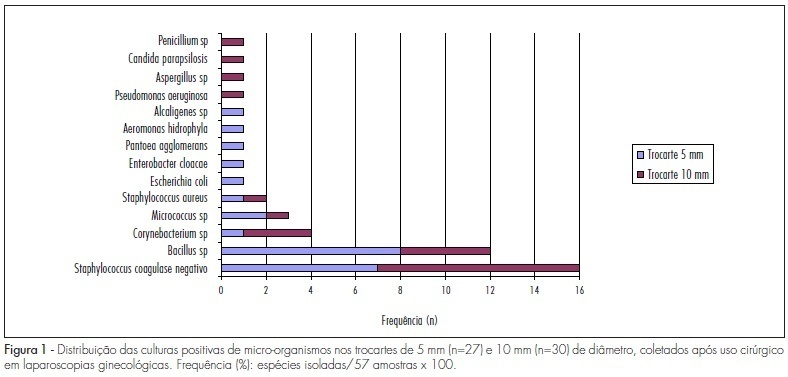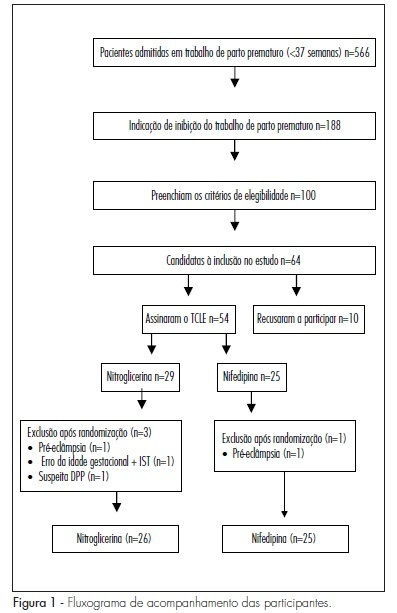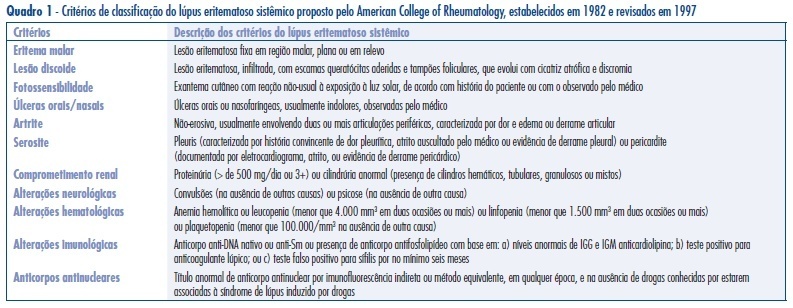Summary
Revista Brasileira de Ginecologia e Obstetrícia. 2009;31(12):586-591
DOI 10.1590/S0100-72032009001200002
PURPOSE: to identify the microbial charge present in reusable trocars used in gynecological laparoscopies. METHODS: a descriptive exploratory study. An amount of 57 trocars, 30 with 10 mm of diameter and 27 with 5 mm, have been collected from the surgical unit, immediately after the surgery and placed in a sterilized recipient, in which 250 mL of sterile distilled water was added. Then, the trocars were agitated for the drainage of particles and to obtain a wash-out fluid to be analyzed. After being filtered through 0.22 µm cellulose membrane, the residue was placed on blood agar plates with a sterilized forceps. Following incubation, microbiological analysis has been done to count the number of colonies and further identify the microorganisms, using standard laboratorial techniques. RESULTS: microbial charge was recovered from 47.4% of the trocars analyzed. Among those, 45.6% presented 1 to 100 growing colonies. Fourteen types of microorganisms have been identified, among which the more frequently isolated were coagulase-negative Staphylococcus (28%) and Bacillus sp (21%), Aeromonas hydrophila, Alcaligenes sp, Candida parapsilosis, and enterobacteries were also identified. CONCLUSIONS: the study has demonstrated that the microbial challenge faced by the technician responsible for the cleaning and sterilization of trocars is low, as compared to the challenge imposed by biological markers. Nevertheless, it may be not inferred that the risks for infectious complications for patients are minimal.

Summary
Revista Brasileira de Ginecologia e Obstetrícia. 2009;31(11):566-573
DOI 10.1590/S0100-72032009001100007
PURPOSE: to identify the profile, tendency and causes of maternal death by pre-eclampsia/eclampsia in Paraná. METHODS: descriptive, transversal cohort study on maternal death by pre-eclampsia/eclampsia from 1997 to 2005. Data were obtained from case studies prepared by Maternal Death Committees that employ the Reproductive Age Mortality Survey Method to examine all the cases of death among women in fertile age. The general and specific maternal death rate (MDR) by pre-eclampsia/eclampsia were considered. To evaluate the tendency, triennial periods have been compared, two by two, taking into consideration the MDR of each period (p<0.05). In the triennial period from 2003 to 2005, 56 deaths by pre-eclampsia/eclampsia were analyzed. The variables focused were: age, income, schooling, gestation number and complications, pre-natal conditions, signs and symptoms related to the condition, delivery route, the time gestation was interrupted, the newborn conditions, access and treatment, ability to avoid and prevention measures. RESULTS: the general triennial MDR has presented significant decline, with 64.3/100,000 born-alive babies. There has been stability along the period for MDR by hypertensive disorder, with MDR of 11.8/100,000 born-alive. Primiparous women, women over 40 and with low socio-economical status have presented higher risks. In relation to the treatment, there has been underuse or inadequate use of conventional medicines for severe pre-eclampsia and eclampsia. The committees' analysis indicated that all the maternal death due to these conditions could have been avoided. CONCLUSIONS: actions aiming at minimizing the set of causes that lead to death by pre-eclampsia in Paraná should be enforced, including the training and monitoring of health professionals in order to apply the treatment protocols, besides the formalization of a reference net of clinics and hospitals, qualified for the care of high risk pregnancy and its intercurrences, to which pre-natal pregnant women are enrolled.
Summary
Revista Brasileira de Ginecologia e Obstetrícia. 2009;31(11):552-558
DOI 10.1590/S0100-72032009001100005
PURPOSE: to compare the effectiveness of transdermal nitroglycerin with oral nifedipine in the inhibition of preterm delivery. METHODS: a clinical essay has been performed with 50 women in preterm delivery, randomly divided into two groups, 24 receiving oral nifedipine (20 mg), and 26, transdermal nitroglycerin (10 mg patch). Patients with a single gestation, between the 24th and the 34th weeks and diagnosis of preterm delivery were selected. Women with fetal malformation and clinical or obstetric diseases were excluded. The variables analyzed were: effective tocolysis, time needed for tocolysis, recurrence frequency, progression to preterm delivery, and side effects. RESULTS: tocolysis efficacy in the first 12 hours was similar between the groups (nitroglycerin: 84.6% versus nifedipine: 87.5%; p=0.50). The time average time needed for tocolysis was also similar (6.6 versus 5.8 hours; p=0.30). There was no difference between the groups, concerning the recurrence of preterm delivery (26.9 versus 16.7%; p=0.30), and neither in the rate of preterm delivery within 48 hours (15.4 versus 12.5%; p=0.50). Nevertheless, the cephalea rate was significantly higher in the Nitroglycerin Group (30.8 versus 8.3%; p=0.04). CONCLUSIONS: transdermal nitroglycerin has presented similar effectiveness to oral nifedipine to inhibit preterm delivery in the first 48 hours, however with higher cephalea frequency.

Summary
Revista Brasileira de Ginecologia e Obstetrícia. 2009;31(11):547-551
DOI 10.1590/S0100-72032009001100004
PURPOSE: to study the effect of acoustic stimulation in the fetal cardiac response, according to parameters from computerized cardiotocography in low risk pregnancies. METHODS: twenty low risk pregnant women were included in the study, according to the following criteria: age over 18; single gestation, living fetus; gestational age between 36 and 40 weeks; amniotic liquid index over 8.0 cm and absence of fetal malformation. Cases with post-natal diagnosis of fetal anomaly were excluded. Computerized cardiotocography was performed for 20 minutes, before and after fetal acoustic stimulation. Results were analyzed by the t test for dependent samples, with significance level at p<0.05. RESULTS: acoustic stimulation was successfully performed in all cases analyzed. By the analysis of the cardiotocographic parameters, there was no significant difference when the pre and post-stimulation parameters were compared: average number of fetal movements per hour (55.6 versus 71.9, p=0.1); mean basal fetal heart rate (FHR) (135.2 versus 137.5 bpm, p=0.3); mean FHR increases>10 bpm (6.5 versus 6.8, p=0.7); mean FHR increases>15 bpm (3.8 versus 4.3, p=0.5); mean duration of high FHR variation episodes (11.4 versus 10.9 min, p=0.7); mean duration of low FHR variation episodes (2.5 versus 1.1 min, p=0.2), and mean short-term variation (10.6 versus 10.9 ms, p=0.6). CONCLUSIONS: in low risk gestations at term, computerized cardiotocography has not evidenced differences in the FHR parameters after the fetal sonic stimulation.
Summary
Revista Brasileira de Ginecologia e Obstetrícia. 2009;31(11):540-546
DOI 10.1590/S0100-72032009001100003
PURPOSE: to verify the association between ultrasonographic signs during gestation and post-delivery evolution in fetuses with bilateral obstructive uropathies, followed up in an expectant way. METHODS: fetuses with bilateral obstructive uropathies presenting severe oligoamnios and narrow thorax have been compared with fetuses with bilateral obstructive uropathies without those alterations, concerning the presence or absence of cysts in both kidneys, and the presence or absence of parenchymal hyperechogenicity in both kidneys. Cases of neonatal death were compared with cases of neonatal discharge from the nursery, regarding the same renal echographic aspects mentioned above, the presence of severe oligoamnios and narrow thorax. The sensitivity, specificity, positive and negative predictive value of the presence of bilateral renal cysts, bilateral renal hyperechogenicity, severe oligoamnios and narrow fetal thorax for the neonatal death were calculated. RESULTS: severe oligoamnios and narrow thorax were more frequent (p=0.03; p<0.001) in fetuses with bilateral renal cysts, as compared to those with echographically normal renal parenchyma. Neonatal death was more frequent among cases with severe oligoamnios (p<0.001), narrow thorax (p<0.001) and bilateral renal cysts (p<0.002), when respectively compared with cases without those alterations. The best values of sensitivity, specificity, positive and negative predictive value for the death of neonatal/breastfeeding infants were obtained using the echographic aspect of narrow thorax, and were 81.8, 100, 100 and 79.3%, respectively. CONCLUSIONS: in cases of fetuses with bilateral obstructive uropathies followed up in an expectant way, the ultrasonographic signs more associated to bad prognosis are severe oligoamnios, narrow fetal thorax and presence of bilateral renal cysts.
Summary
Revista Brasileira de Ginecologia e Obstetrícia. 2009;31(11):534-539
DOI 10.1590/S0100-72032009001100002
PURPOSE: to analyze the ophthalmic artery functioning in pregnant women with systemic lupus erythematosus (PL) without active renal disease as compared to non-pregnant women with lupus (NPL) without active renal disease, and to normal pregnant women (PN). METHODS: observational study that analyzed ophthalmic artery dopplervelocimetric variables of 20 PN, 10 PL and 17 NPL women. The variables analyzed were: pulsatility index (PI), final diastolic velocity (FDV) and velocity peak ratio (VPR). Mean and standard deviation of these indexes were calculated. For group mean comparison, analysis of variance (ANOVA) and the post-hoc Tukey test have been used, with confidence interval of 95% (p<0.05). RESULTS: the PN group showed the following means and standard deviations of ophthalmic artery parameters: PI=2,4±0,3; VPR=0,5±0,1 e FDV=5,1±2,1 cm/s. The PL and NPL groups showed the following values, respectively: PI=2,0±0,4 and 1,9±0,4; VPR=0,6±0,1 and 0,6±0,1; FDV=9,7±3,9 cm/s and 8,1±4,3 cm/s. There was not significant mean difference between the PL and NPL groups for PI, VPR or FDV. However, statistically significant mean differences were observed between PN and PL for PI, VPR and FDV, with higher values of FDV and VPR in the PL group. CONCLUSIONS: there was a reduction of ophthalmic artery vascular impedance with orbital hyperfusion in the two groups of women with lupus erythematosus as compared to normal pregnant women. These results may help to improve the understanding on pathophysiology of systemic lupus erythematosus. In addition, the present method may be applied in future studies as a complementary procedure for the differential diagnosis between pre-eclampsia and renal failure due to lupus.
